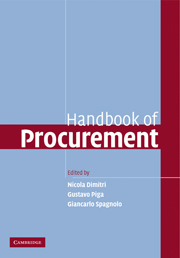Book contents
- Frontmatter
- Contents
- List of figures
- List of tables
- List of contributors
- Preface
- Part I Preliminary Issues
- Part II General Strategic Principles
- 3 When should procurement be centralized?
- 4 Procurement contracting strategies
- 5 Incentives and award procedures: competitive tendering vs. negotiations in procurement
- Part III Competitive Tendering Strategies
- Part IV Attracting and Screening Participants
- Part V Preventing Collusion and Corruption
- Part VI Dynamic Forces and Innovation
- Glossary
- Index
- References
5 - Incentives and award procedures: competitive tendering vs. negotiations in procurement
Published online by Cambridge University Press: 04 November 2009
- Frontmatter
- Contents
- List of figures
- List of tables
- List of contributors
- Preface
- Part I Preliminary Issues
- Part II General Strategic Principles
- 3 When should procurement be centralized?
- 4 Procurement contracting strategies
- 5 Incentives and award procedures: competitive tendering vs. negotiations in procurement
- Part III Competitive Tendering Strategies
- Part IV Attracting and Screening Participants
- Part V Preventing Collusion and Corruption
- Part VI Dynamic Forces and Innovation
- Glossary
- Index
- References
Summary
Introduction
Manufactured goods, such as computers, TVs and automobiles are mass produced, have standardized characteristics and are typically purchased at list price. Other goods, such as new buildings, fighter jets, custom software or consulting services are tailored to fit a procurer's specific and often unique needs. To procure these customized goods, the procurer hires a contractor who supplies the goods according to a set of desired specifications. We call this the procurement problem.
The procurement problem has attracted much attention both in policy and in academic circles. The main focus of academic economists has been on procurement by the public sector, in part because of its sheer importance to the economy. For example, procurement by federal, state and local government accounts for more than 10 percent of Gross Domestic Product in the United States. Many private sector transactions are also governed by procurement contracts. Prominent examples include electronics components, custom software, automobile production and building construction.
When considering the procurement of goods and services, the procurer is faced with many challenges. First, she has to choose what exactly should be procured, and how to transmit her needs to the potential suppliers. Second, a contract must be laid out that includes contractual obligations and methods of compensation. Third, the procurer needs to decide how to award the procurement contract between the potential suppliers.
- Type
- Chapter
- Information
- Handbook of Procurement , pp. 121 - 140Publisher: Cambridge University PressPrint publication year: 2006
References
- 25
- Cited by



